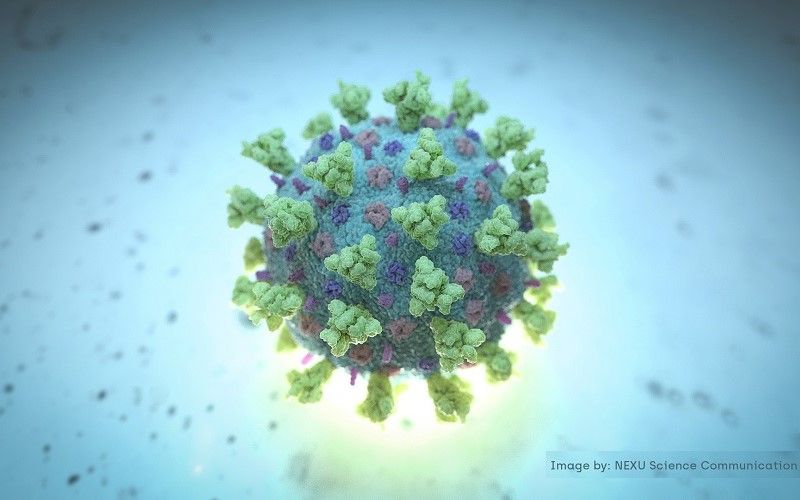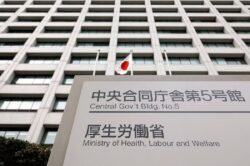
A computer image shows a model structurally representative of a betacoronavirus which is the type of virus linked to COVID-19.
11:46 JST, June 6, 2021
The COVID-19 pandemic is an extraordinary circumstance. Although it is showing no signs yet of coming to an end, it is about time to begin considering what Japan should do as a state in a post-pandemic era. To do so, it is necessary for us to select which of the experiences we have had in the past year or so to seriously learn from.
The most important thing we now need to acknowledge is the manifest absence in Japan of organizations and capabilities to deal with extraordinary circumstances as a state. The country was unable to quickly implement a large number of necessary PCR tests. The government failed to launch and spearhead a national coronavirus vaccine development effort. And, as we now are witnessing, it is likely to take months to vaccinate a sufficient number of people. All of these exhibit the inadequacy of emergency organizations and capabilities in Japan as a state.
Former Prime Minister Shinzo Abe must have been deeply frustrated as most of what he ordered had not been implemented properly. So must Prime Minister Yoshihide Suga have been.
Orders cannot be implemented unless there are effective institutions and necessary capabilities. Nobody is lazy. One cannot implement what is not prepared. One cannot realize what is impossible.
Why is it impossible? It’s because in a large-scale crisis a huge number of people beyond non-crisis norms is required to overcome the situation. As is often pointed out, there was a tremendous shortage of people to carry out PCR tests across Japan and trace infected people on a massive scale. Suddenly, an extra number of doctors and nurses in addition to those who are treating regular diseases were needed to take care of COVID-19 patients. Likewise, to set out a rapid nationwide across-the-board vaccination program, it is indispensable to mobilize medical and logistics professionals en masse. How successful the Japanese vaccination campaign will be depends on how many professionals with inoculation licenses can be mobilized from now on.
What should be done for a post-pandemic future? Certainly, it is not a practical option for the government to prepare, on a permanent basis, both personnel and resources necessary to manage every crisis. Infectious diseases are not the only extraordinary circumstance that will occur again in the future. If the government intended to be in constant readiness to deal completely on its own with major earthquakes, tsunami, devastating floods, nuclear power accidents, external invasion, large-scale terrorist attacks and so on, it would have to continuously employ an exceptional number of redundant personnel in non-crisis times.
A realistic approach is to work out and install a combination of governmental and civil systems to cope with an emergency. The government should regularly maintain a certain level of personnel and resources that can be readily and effectively deployed in an emergency, while, at the same time, it should be empowered to “mobilize” personnel and resources from society and the market as required in such a situation. Needless to say, the prototype of this approach is a wartime national mobilization system. Under it, the state maintains a minimum level of both armed strength and military materiel manufacturing capabilities in peacetime, but, in the event of an emergency, the government will either call in reserves or expand the armed forces through conscription and increase military materiel production all at once by mobilizing private-sector resources at its discretion. During World War II, the United States employed this pattern most effectively.
In Japan, because of the disastrous prewar and wartime national mobilization, any attempt reminiscent of the wartime experiences has largely been repulsed. Therefore, it is only in the 21st century that Japan finally adopted emergency-related legislation. Yet, there is still no move at all in the country to draft a nationwide mobilization system to be enforced in wartime.
However, the pattern in which the government maintains basic capabilities in normal circumstances and “mobilizes” personnel and resources from society and the market in an emergency is not something limited to use during a wartime situation.
In its struggle with COVID-19, Washington invoked the Defense Production Act to exercise presidential power for facilitating the development and production of vaccines by Pfizer and other pharmaceutical firms. So, it is no accident that countries with mobilization capabilities such as the United States, Britain and Israel have outpaced other countries in terms of COVID-19 vaccination coverage.
In Japan, too, municipal governments usually make preparations for large-scale natural disasters on their own and, only in the event of a catastrophic one, ask the Self-Defense Forces for emergency support, and volunteers and businesses for cooperation in recovery and reconstruction efforts. In the wake of the Great East Japan Earthquake, officials of numerous municipal governments across Japan came to the aid of the local governments in the Tohoku region that were affected by the calamity.
A similar pattern has been repeated since the outbreak of the COVID-19 pandemic. Suga’s instruction to the SDF to run mass vaccination centers is an example of deployment of the crisis management apparatus of the state readily available. Abe’s decisions to outsource a project to distribute masks to the entire population and to develop the COVID-19 contact-confirming app COCOA were examples of mobilizing resources and personnel from the market. The government’s call for inactive nurses — who are not in the health care system despite having nursing licenses — to come back to the field to administer vaccine shots in its nationwide vaccination program is an act of mobilizing dormant human resources from society.
The problem is that the government did not have sufficient organizational capabilities of crisis response when the pandemic hit the country and failed to mobilize society and the market rapidly and effectively. True, the SDF is the organization of last resort for the nation. But it is not the core organization responsible for responding to a health care crisis. The government should urgently begin considering enhancing the competence of the National Hospital Organization, the National Institute of Infectious Diseases and public health centers to sufficiently cope with future pandemics like COVID-19.
What is likely to be more essential is to develop a “mobilization system.” As mentioned earlier, even in the event of an emergency, the government cannot do everything on its own. The obstacle Japan now faces is a lack of clarity regarding what specific orders the government can give to the market and society in a national crisis.
The revised special measures law to cope with new strains of influenza, which facilitates measures against the coronavirus, should have been adopted around last summer just after the first wave of the pandemic. Even so, the belated revision itself was welcome. However, the law mostly stipulates a series of “don’ts” such as requiring restaurants to shut their doors at a designated time and serve no alcohol while a state of emergency or emergency-level priority measures are in place to prevent the spread of COVID-19.
On the other hand, we need a system comprising a series of “do’s” as well. The revised Infectious Diseases Law requires medical institutions to provide beds for infected patients. This is one of the “do’s.” However, compared with the “don’ts,” generally speaking, it is more difficult to realize a system in which “do” steps will be carried out. When “do” instructions are related to something that is not feasible in the first place, nothing can be achieved no matter how many orders are issued. Better planning is essential to cultivate capabilities to be mobilized in a crisis.
In other words, it is impossible to procure a certain type of good when the market cannot provide it. We need to remember how difficult it was for the government to distribute masks to each person in the country.
In the case of app development, an approach to leave everything to the market does not always work well. Likewise, even a scheme to recruit inactive nurses from society can hardly work well unless it is coupled with a system that gives due consideration in advance to the circumstances surrounding the relevant nurses.
A possible emergency occurring in Japan in the future may take the form of an even worse infectious disease or a large-scale natural disaster. It could even be a more severe emergency, namely a national security crisis.
The government should closely examine and improve the scale and functions of each core organization the state must maintain on a permanent basis for undertaking emergency-response missions.
The government must also prepare relevant laws that are essential for it to mobilize personnel and resources from society and the market in the event of various emergencies. Further, the government needs to keep a dialogue with the market and society while working on a framework to realize effective mobilization of resources and personnel from them with due consideration to private rights.
Akihiko Tanaka
Tanaka is president of the Tokyo-based National Graduate Institute for Policy Studies (GRIPS), a post he assumed in April 2017. Previously, he was a University of Tokyo professor specializing in international politics. He was president of the Japan International Cooperation Agency from 2012 to 2015 and vice president of the University of Tokyo from 2009 to 2012.
"Society" POPULAR ARTICLE
-

M4.9 Earthquake Hits Tokyo, Neighboring Prefectures
-

Israeli Tourists Refused Accommodation at Hotel in Japan’s Nagano Pref., Prompting Protest by Israeli Embassy and Probe by Prefecture
-

M7.5 Earthquake Hits Northern Japan; Tsunami Waves Observed in Hokkaido, Aomori and Iwate Prefectures
-

Tsukiji Market Urges Tourists to Avoid Visiting in Year-End
-

M5.7 Earthquake Hits Japan’s Kumamoto Pref., Measuring Upper 5 Intensity, No Tsunami Expected
JN ACCESS RANKING
-

Keidanren Chairman Yoshinobu Tsutsui Visits Kashiwazaki-Kariwa Nuclear Power Plant; Inspects New Emergency Safety System
-

Tokyo Economic Security Forum to Hold Inaugural Meeting Amid Tense Global Environment
-

Imports of Rare Earths from China Facing Delays, May Be Caused by Deterioration of Japan-China Relations
-

University of Tokyo Professor Discusses Japanese Economic Security in Interview Ahead of Forum
-

Japan Pulls out of Vietnam Nuclear Project, Complicating Hanoi’s Power Plans
























